Essential oil fortification and their applications in poultry
Published: August 18, 2020
By: Ajay Chalikwar / Zonal Technical Manager, Provet Pharma Private Limited, Chennai, India.
INTRODUCTION
Resistance of pathogenic bacteria towards anti-microbials forced poultry industry to explore alternative solutions like prebiotics, probiotics, organic acids, bacteriophages, antimicrobial peptides, lysozymes, lactoferrins and phytogenics / essential oils (EOs).

One of the safe and efficient alternative is essential oils, also called as zoo-technical additives. Essential oils are less toxic and typically more residue-free compared to synthetic antibiotics thereby ensuring animal welfare and food safety. Recently, use of essential oils along with short chain fatty acids in broilers, layers and breeders has drawn attention.
OVERVIEW OF ESSENTIAL OILS
The term “essential oils” was first coined by Paracelsus von Hohenheim in the 16th century (Guenther., 1948). Essential does not mean that these are essential (Oyen and Dung, 1999) but it denotes the essence (flavour) they obtain from different parts of the plant like root, stem, bark, fruit, flower, etc. Currently, there are over 3,000 known essential oils with approximately 300 being commercially relevant (Diaz-Sanchez et al., 2015).
Quality of essential oils depends on environmental condition, climate, harvesting time, part of the plant, soil type and extraction method. Essential oils can be obtained through various methods like fermentation, extraction or expression but most common method is steam distillation (Raut and Karuppayil, 2014).
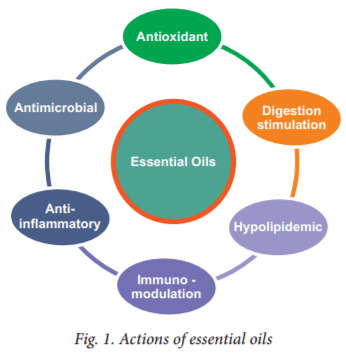
Essential oils are a mixture of fragrant and volatile compounds, sensitive to heat and light, chemically comprised of two classes, i.e., terpenes and phenylpropenes (Cooke et al., 1998).
Essential oil constituents are quickly absorbed after oral administration and are either metabolized or eliminated by the kidneys in the form of glucuronides or exhaled as CO. Their accumulation in the body is unlikely 2 due to rapid clearance and short half-lives (Lee et al., 2004). Essential oils are found to have antibacterial, antifungal, antiviral activity and also exhibit antioxidant, anti-inflammatory, anti-carcinogenic, digestion stimulating & hypolipidemic activities (Viuda-Martos et al., 2010). Besides, other beneficial effects of essential oils include appetite stimulation, improvement of endogenous digestive enzyme secretion and immune response activation.
Recently essential oils along with short chain fatty acids are used to improve body weight gain, feed conversion, egg production and disease resistance in poultry. As essential oils are highly reactive and possess strong odour & taste, they need to undergo micro-encapsulation process which will help them in sustaining pelleting temperature and increasing their shelf life.
PROPERTIES & ACTIVITIES
Antimicrobial activity
Antibacterial activity is not an outcome of a specific mode of action but it is a cumulative effect of various mechanisms which are dependent on pH, chemical structure, presence of functional groups (Farag et al.,1989), dose of active ingredient and quorum of microbes (Burt, 2004). Cell membrane is disrupted by terpenoids & phenolics, metal ions chelated by phenols & flavonoids and bacterial growth affected by alkaloids (Cowan, 1999).
Essential oils are very effective on Salmonella, E. coli, Clostridium and other pathogenic bacteria, (Cosentino et al.,1999) virus and fungi (Smith-Palmer et al., 1998.) Cinnamaldehyde, Carvacrol, Citral, Thymol and Eugenol exert fair antibacterial effect (Dormans and Deans, 2000). Essential oils can potentially reduce the incidence of Salmonella in broiler carcasses and in the broiler house with a positive impact on food safety (Bento et al., 2013).
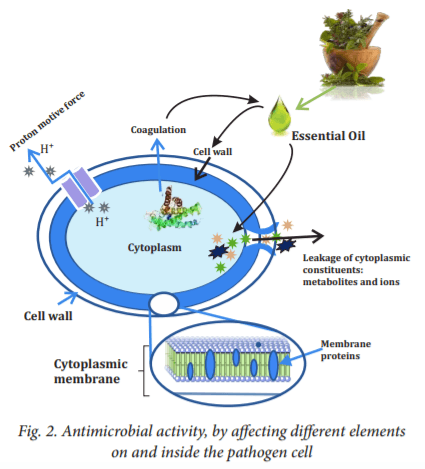
Cinnamaldehyde exerts antifungal activity by acting on sulfhydryl groups (Kurita et al., 1979) and inhibit fungal cell wall synthesis (Bang et al., 2000) which is necessary for fungal growth. Microbes use quorum-sensing to orchestrate collective population behaviour including bio-film formation and/or virulence factors secretion which is dependent upon the production and release of specific chemicals/signals at a population-wide scale. Phytochemicals derived from multiple medicinal plants of the Myrtaceae family-like Clove, Guava, Eucalyptus (Musthafa et al., 2017) and Cinnamaldehyde (Pande et al., 2013) inhibit quorum sensing and overcome increasing virulence factors of pathogenic bacteria.
Antiparasitic activity
Essential oils are potent botanical products which either interfere directly with parasitic metabolism or indirectly by enhancing the host immune response and antioxidant defence system for the effective control and eradication of parasitic invasion. It also helps in reducing intestinal lesions and faecal oocyst shedding in the litter. Phenols have oocysticidal action, control coccidiosis infection (Williams, 1997) and endoparasites in the gut.
It has been suggested that EOs are an effective alternative to coccidiostats, on the basis of improvements in performance & significant reduction in the post infection faecal blood discharge. Carvacrol and Thymol have anticoccidial action against E. tenella (Giannenas et al., 2003) and mixed Eimeria spp. infection (Oviedo-Rondon, 2003).
Antioxidant property
Essential oils are potent botanical products which either interfere directly with parasitic metabolism or indirectly by enhancing the host immune response and antioxidant defence system for the effective control and eradication of parasitic invasion. It also helps in reducing intestinal lesions and faecal oocyst shedding in the litter. Phenols have oocysticidal action, control coccidiosis infection (Williams, 1997) and endoparasites in the gut. Essential oils have an inherent ability to donate electrons to the free radicals produced during the process of lipid peroxidation (Fernandez-Panchon et al., 2008). Essential oils increase the keeping quality of meat by attenuating oxidative injury and improving redox balance in blood, muscles and tissues. It also influences the in vivo antioxidant defence systems such as Superoxide dismutase and Glutathione peroxidase. Phenolics have potent antioxidant activity than Vitamin E, Vitamin C & Vitamin A and they improve the hepatic concentration of coenzyme Q10 (Rice-Evans et al.,1997). Thymol, Carvacrol and other essential oils can act as antioxidants in egg and meat of chickens when introduced in the diets (Lee et al., 2004). Supplementation of Carvacrol, Capsaicin and Cinnamaldehyde can increase the number of goblet cells and secretion of mucin on the surface of villi, providing better protection against invading infectious agents.
Stimulation of Digestion
Essential Oils improve digestion by stimulating secretion of bile, mucus and various digestive juices like trypsin, amylase and jejunal chyme (Manzanilla et al., 2004). Improvement in activity of total amylase, trypsin, and maltase is observed upon inclusion of essential oils in diets (Jang et al., 2007).
Essential oils significantly increase the villus width and surface area, indicative of improved nutrient absorption (Geyra et al., 2001) and performance (Choct, 2009) and reduce the adherence of pathogens. Cinnamaldehyde helps to increase the bile secretion (Harada and Yano,1975).

Anti-inflammatory activity
Essential oils have been used traditionally for centuries as an anti-inflammatory drug to alleviate symptoms associated with eczema, dermatitis and other pronounced irritations (Kamatou and Viljoen, 2010). Terpenoids and flavonoids suppress metabolism of inflammatory prostaglandins and reduce inflammatory conditions (Craig, 2001). Other essential oils (eucalyptus, rosemary, lavender, millefolia) and other plants (pine, clove and myrrh) have been used in mixed formulations as anti-inflammatory agents (Darsham and Doreswamug, 2004).
Essential oils contain phenolic compounds that are known to possess strong anti-inflammatory properties. The major EO substances having anti-inflammatory abilities are the terpenoids and flavonoids. These substances suppress the metabolism of inflammatory prostaglandins.
Lipid metabolism
The hypolipidemic effect of essential oils is carried out through the inhibition of HMG-CoA reductase activity, a key regulatory enzyme in the cholesterol synthesis process (Crowell, 1999). Significant reduction in the serum cholesterol level of broilers fed with cinnamon powder was observed (Gopi et al. 2012).
Immunomodulatory activity
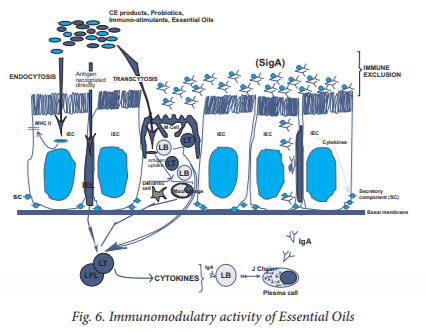
This activity is a result of optimizing production of interleukins, γ interferons and TNF α. Essential oils increase phagocytic activity of macrophages and Antigen Processing Cells (APC) (Hanieh et al., 2010). Another mode of improving immunity is through increasing weight and activity of immune organs like bursa of fabricius and spleen (Rahimi et al., 2011).
There will be an increase in IgG, IgA, IgM, CD3 and CD4 serum levels and ND titre values when birds are provided with essential oils (Rezaei–Moghadam et al. 2012). It is well known that many diseases/disorders, that have immunomodulated components, can be treated by administration of biological compounds that activate key pathways in the immune system. They strengthen the defence and immune mechanisms of the body and can be used for stimulating the non-specific immune response in both human and veterinary medical practice (Awaad et al. 1999).
Positive effect on gut microbiota
Many essential oils stimulate growth of beneficial microbes and reduce the number of pathogenic bacteria in gut (Wenk, 2000). Similarly, Capsaicin, Carvacrol and Cinnamaldehyde will have a positive impact on gut microbiota and growth performance (Jamroz et al., 2005)
Activity of intestinal microbiota leads to synthesis of SCFAs as a result of digestion of indigestible fibre which provides additional source of energy for the host (Li et al., 2012). Essential oils also increase the proportion of SCFAs, butyrate in the caecum which is known to provide energy to colonic mucosa (Roediger, 1980) and thus have potentially important implications for intestinal immunity (Hamer et al., 2008).
Effect on Growth Performance
Dietary essential oils may act not only on intestinal microflora, but also on nutrient utilization (Bento et al., 2013) in broilers, layers and breeders. Essential oils improve growth performance by stimulating the secretion of digestive enzymes leading to improved nutrient digestion, rate of gut passage or feed intake (Jamroz et al., 2005).
SHORT CHAIN FATTY ACIDS
Short chain fatty acids (SCFA) with sodium, potassium and calcium salts are commonly used for controlling susceptible pathogenic bacteria particularly gram negative ones. Butyric, propionic, formic and acetic acids are commonly used SCFAs in poultry for performance elevation. Salts / uncoated SCFAs will get neutralized easily in the foregut and very less antibacterial activity will be retained due to their dissociation but gut acidification will be taken care up to some extent.
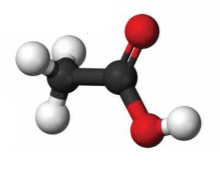
Coated or esterified SCFAs / organic acids are used which are more resistant against being neutralized in the foregut and provide good action in the hind gut against susceptible bacteria but acid available in undissociated form in the hind gut is highly variable. The use of organic acids has been reported to protect the young chicks by competitive exclusion (Mansoub et al., 2011), enhancement of nutrient utilization, growth, feed conversion efficiency, immunity and performance in broiler and laying hens (Luckstadt and Mellor, 2011).
SCFAs are also involved in prevention of diarrhoea (water and Na absorption), pH control within the gastrointestinal tract, and defence against pathogens (colonization resistance). SCFAs are helpful in decreasing intestinal E. coli and Salmonella spp. (Hassan et al., 2010).

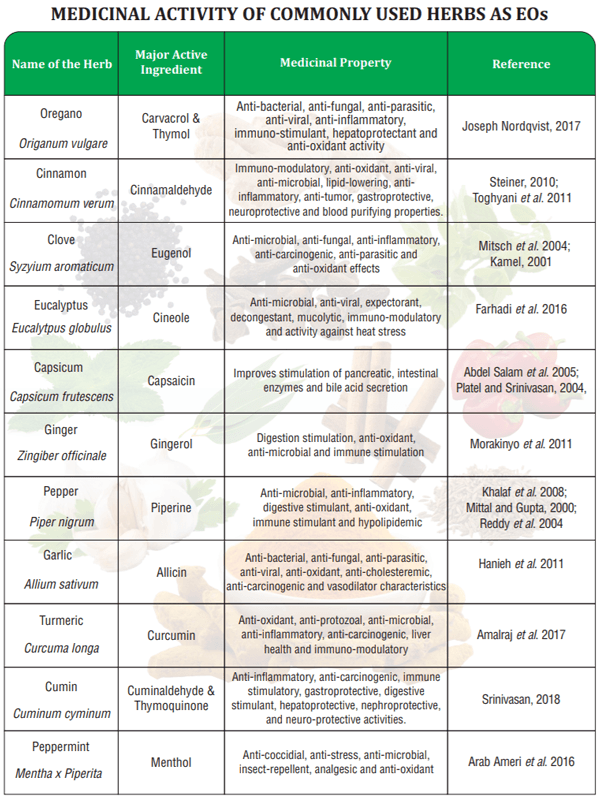
It has been shown that SCFAs inhibit the growth of Salmonella (Van Immerseel et al., 2003), Aspergillus (M.A. Coaker et al., 2006) and Penicillium (Mariko ERA, 2015). SCFAs reduce cytoplasmic pH and stop metabolic activities of susceptible bacteria. SCFAs will cause death of susceptible organisms by acting on cytoplasmic membrane by neutralizing its electrochemical potential and increasing its permeability. Once hydrogen ion is injected through the lipopolysaccharide layer on the cell wall of susceptible bacteria, pH of intracellular contents will be reduced and this process consumes a great amount of energy to maintain intracellular homeostasis and causes bacterial cell death. SCFAs will improve gut health by reducing damage of intestinal cells by pathogenic bacteria and improve birds' performance in terms of body weight gain, FCR, maintain egg production, reduce egg shell contamination, and reduce litter contamination in broiler, layer and breeders.
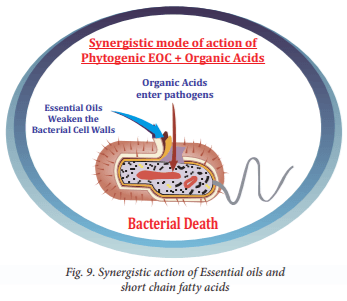
CONCLUSION
Controlling of gut pathogens can be done by using AGP/NAGPs and its main purpose is to attain good gut health and keeping the stressor agents at bay. Synergistic effect of essential oils with SCFAs will exert broad spectrum antimicrobial effect and help in reducing clinical and sub clinical infections caused by Salmonella, E. coli, Staphylococci and Clostridium in the gut as well as systemically. In broilers, it helps in improving bird performance, health status, immunity and feed conversion. In layers and breeders, it is employed for improving egg production and egg quality, health status of birds, feed efficiency, immunity and reduction in the percentage of cracked/broken eggs. Essential oils will play a huge role in the poultry industry development in the near future due to its unique and traditionally used components like herbs/spices from our kitchens. No agent is ideal unless proper management, feeding, brooding conditions, feed form (pelleted / mash), preventive vaccination and strict biosecurity are maintained at farm level.
AGP / NAGP performance is partially dependent on other factors like effective rotation/shuttle programme of coccidiostat in feed, hence proper attention should be paid towards coccidiosis control programme. The replacement of AGPs with other safe and natural alternatives is an important objective for poultry industry. There are some promising results on the use of essential oils as performance enhancers.
Application of essential oils with SCFAs in the poultry diet could be used as antimicrobial, antioxidant, immuno-modulating and anti-inflammatory agents to produce low cholesterol meat, juicy and tender meat, fortified eggs and improved productivity with better survival rate.
Related topics:
Authors:
Recommend
Comment
Share
Recommend
Reply

Would you like to discuss another topic? Create a new post to engage with experts in the community.









.jpg&w=3840&q=75)